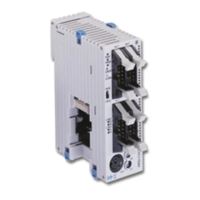Communication
FPΣ User's Manual
174
8.5.2 Command and Response Format
Command message
All command-related items should be noted in the text segment. The station number must be
specified before sending the command.
01#RCSR0001
C
R
%
1
Start code
Commands must always have a "%" (ASCII code: 16#25) or a "<" (ASCII code: 16#3C) at the beginning of a
message.
The FPΣ supports an expansion start code ("<") to send single frames of up to 2048 characters. Using the
start code "%", a maximum of 118 characters can be sent in one frame.
2
Station number
The station number of the slave to which you want to send the command must be specified.
The range is 01 to 99 (decimal).
In 1:1 communication, the station number "01" (ASCII code: 16#3031) should be specified.
3
Text
The content differs depending on the command. The content should be noted in all upper-case characters,
following the fixed formula for the particular command.
The method for writing text segments in the message varies depending on the type of command.
4
Check code
Hexadecimal block check code (BCC) for error detection using horizontal parity. The BCC should be created
so that it targets all of the text data from the header to the last text character.
The BCC starts from the header and checks each character in sequence, using the exclusive OR operation,
and replaces the final result with character text. It is normally part of the calculation program and is created
automatically.
The parity check can be skipped by entering "* *" (ASCII code: 16#2A2A) instead of the BCC.
5
End code
Messages must always end with a "
C
R
" (ASCII code: 16#0D).
6
Target address
Address of the target area to be read or written (e.g. internal relay R1)
7
Data area
Specification of the number of points to be read or written (S = 1 point)
8
Command name
e.g. RC, read contact area
9
Command code
# (16#23) indicates that this is a command

